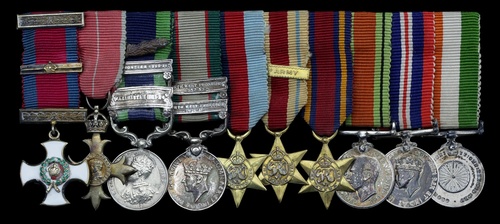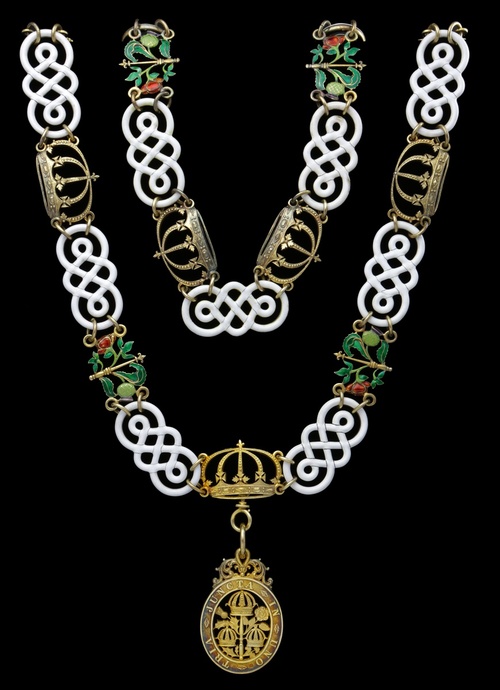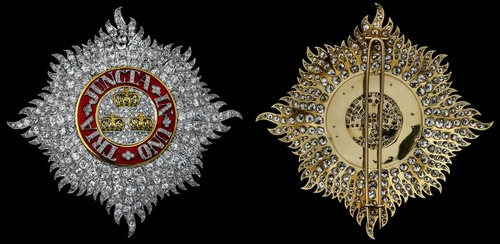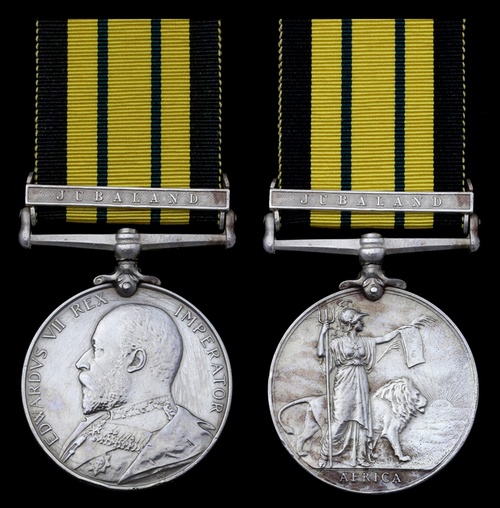The outstanding 'Gallipoli Landings' D.C.M. group of four awarded to Sergeant F. Palmer, Royal Fusiliers, decorated and mentioned in Sir Ian Hamilton's dispatches for 'gallantry and marked ability' during operations at Cape Helles from 25 April 1915 As section commanders fell around him, Palmer took control of his Company's scattered remnants and led them forward to successfully capture Hill 114. From this position, the Royal Fusiliers were able to stall the Turkish advance on Hill 138, saving the British centre at a critical moment Promoted to Sergeant, Palmer was assigned to his regiment's inexperienced 20th Battalion, which fought at the Battle of Arras. Leading from the front, Palmer was killed in action by German machine-gun fire during a night attack on 16 April 1916 Distinguished Conduct Medal, G.V.R. (15052 Pte. F. Palmer. 2/R. Fus:); 1914-15 Star (15052 Pte. F. Palmer. R. Fus:); British War and Victory Medals, with M.I.D. oak leaf (L-15052 Sjt. F. Palmer. R. Fus.), Bronze Memorial Plaque (Fred Palmer), extremely fine, beautifully displayed with his M.I.D. certificate signed by Winston Churchill his personal copy of The New Testament, dried flower petals from a bouquet laid across his grave by his family in 1920, and fourteen original photographs, in a contemporary hinged cherrywood box with glazed compartments and inlay borders, 204mm x 345mm (4) D.C.M. London Gazette 3 July 1915: 'On 25th April, 1915, during operations at Cape Helles, for gallantry and marked ability in collecting men whose section leaders had been killed, and leading them in the attack.' M.I.D. London Gazette 5 August 1915: 'For gallant and distinguished services in the Field.' Fred Palmer was born at Clerkenwell, London in 1899, the fourth son of a St. Pancras bricklayer. The 1911 census records him living at 64 Collier Street, King's Cross. Following the outbreak of war he enlisted into the 2nd Battalion, Royal Fusiliers (City of London Regiment) when it returned to London from Calcutta in December 1914. Assigned to Brigadier-General S. W. Hare's 86th Brigade, 29th Division, this Battalion sailed for the Balkans theatre in March 1915 with a strength of 25 officers and 918 other ranks. Arriving at Tenedos at 4 a.m. on 24 April, it boarded H.M.S. Euryalus ready to land the next day. 86th Brigade landed at X, W and V Beaches on the Gallipoli Peninsula, suffering immediate casualties from Turkish rifle and machine-gun fire. Landing craft afforded no protection, and men drowned under the weight of their heavy packs. The Brigade Major was among the first casualties, the chain of command rapidly disintegrating as officers and NCOs fell. It was against this backdrop that Private Palmer earned his D.C.M., coolly taking command after the section leaders had been killed. Upon landing, the Royal Fusiliers faced a belt of barbed wire 15 foot thick. Captain Geddes of the Royal Munster Rifles described it as: 'the most fearsome I saw on any front. Solid metal stakes riveted to plates sunk in the ground.' Men detailed as wire-cutters were mown down by Turkish fire, but the Royal Fusiliers never faltered. By 9 a.m. they were in possession of Hill 114 and the adjacent redoubts. This advanced position left them vulnerable, and they faced determined Turkish counter-attacks. At 10 a.m. the Essex Regiment shored up their right flank, but further reinforcements were unlikely after the disastrous fate of the River Clyde. The Brigade's War Diary (WO 95/4310) records the afternoon's operations: '25 May, 2.20 p.m.: Royal Fusiliers were ordered to advance and press attack from Hill 114 in order to prevent the Turks bringing greater strength against Hill 138: they were told the situation and carried out the order. During the night 25th/26th there was very heavy firing and every man available was used for defence.' The seizure of a strongpoint known as 'Old Fort' at 2.30 p.m. on 26 April did much to strengthen the Allied position, giving 86th Brigade time to bury its dead. On
The outstanding 'Gallipoli Landings' D.C.M. group of four awarded to Sergeant F. Palmer, Royal Fusiliers, decorated and mentioned in Sir Ian Hamilton's dispatches for 'gallantry and marked ability' during operations at Cape Helles from 25 April 1915 As section commanders fell around him, Palmer took control of his Company's scattered remnants and led them forward to successfully capture Hill 114. From this position, the Royal Fusiliers were able to stall the Turkish advance on Hill 138, saving the British centre at a critical moment Promoted to Sergeant, Palmer was assigned to his regiment's inexperienced 20th Battalion, which fought at the Battle of Arras. Leading from the front, Palmer was killed in action by German machine-gun fire during a night attack on 16 April 1916 Distinguished Conduct Medal, G.V.R. (15052 Pte. F. Palmer. 2/R. Fus:); 1914-15 Star (15052 Pte. F. Palmer. R. Fus:); British War and Victory Medals, with M.I.D. oak leaf (L-15052 Sjt. F. Palmer. R. Fus.), Bronze Memorial Plaque (Fred Palmer), extremely fine, beautifully displayed with his M.I.D. certificate signed by Winston Churchill his personal copy of The New Testament, dried flower petals from a bouquet laid across his grave by his family in 1920, and fourteen original photographs, in a contemporary hinged cherrywood box with glazed compartments and inlay borders, 204mm x 345mm (4) D.C.M. London Gazette 3 July 1915: 'On 25th April, 1915, during operations at Cape Helles, for gallantry and marked ability in collecting men whose section leaders had been killed, and leading them in the attack.' M.I.D. London Gazette 5 August 1915: 'For gallant and distinguished services in the Field.' Fred Palmer was born at Clerkenwell, London in 1899, the fourth son of a St. Pancras bricklayer. The 1911 census records him living at 64 Collier Street, King's Cross. Following the outbreak of war he enlisted into the 2nd Battalion, Royal Fusiliers (City of London Regiment) when it returned to London from Calcutta in December 1914. Assigned to Brigadier-General S. W. Hare's 86th Brigade, 29th Division, this Battalion sailed for the Balkans theatre in March 1915 with a strength of 25 officers and 918 other ranks. Arriving at Tenedos at 4 a.m. on 24 April, it boarded H.M.S. Euryalus ready to land the next day. 86th Brigade landed at X, W and V Beaches on the Gallipoli Peninsula, suffering immediate casualties from Turkish rifle and machine-gun fire. Landing craft afforded no protection, and men drowned under the weight of their heavy packs. The Brigade Major was among the first casualties, the chain of command rapidly disintegrating as officers and NCOs fell. It was against this backdrop that Private Palmer earned his D.C.M., coolly taking command after the section leaders had been killed. Upon landing, the Royal Fusiliers faced a belt of barbed wire 15 foot thick. Captain Geddes of the Royal Munster Rifles described it as: 'the most fearsome I saw on any front. Solid metal stakes riveted to plates sunk in the ground.' Men detailed as wire-cutters were mown down by Turkish fire, but the Royal Fusiliers never faltered. By 9 a.m. they were in possession of Hill 114 and the adjacent redoubts. This advanced position left them vulnerable, and they faced determined Turkish counter-attacks. At 10 a.m. the Essex Regiment shored up their right flank, but further reinforcements were unlikely after the disastrous fate of the River Clyde. The Brigade's War Diary (WO 95/4310) records the afternoon's operations: '25 May, 2.20 p.m.: Royal Fusiliers were ordered to advance and press attack from Hill 114 in order to prevent the Turks bringing greater strength against Hill 138: they were told the situation and carried out the order. During the night 25th/26th there was very heavy firing and every man available was used for defence.' The seizure of a strongpoint known as 'Old Fort' at 2.30 p.m. on 26 April did much to strengthen the Allied position, giving 86th Brigade time to bury its dead. On















Try LotSearch and its premium features for 7 days - without any costs!
Be notified automatically about new items in upcoming auctions.
Create an alert